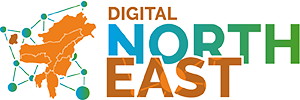About Sikkim
Sikkim, one of the eight north-eastern states of India, is situated in the Eastern Himalayas between 22°56' N – 24° 32' N latitude and 90°09' E – 9220' E longitude. As of the 2011 Census of India, Total population of Sikkim is 607,688 persons, of which 3, 21,661 are males and 2, 86,027 are females, with total area of about 7096 square kilometres. There are more than 460 villages in all the four districts of Sikkim.
Its boundary the state of West Bengal to the south, and international boundaries with three countries, i.e., Nepal, Bhutan and China. Tibet in the north and northeast, Bhutan in the east, Nepal in the west. Sikkim is a small Himalayan state and has no open valley and no plains but carried elevations ranging from 300 to 8583 metres above mean sea level consisting of lower hill, middle and higher hills, alpine zones and snow bound land.
The climate of Sikkim can be divided into five ranges, i.e., Tropical-below 610 meters, Sub-Tropical-610 to 1524 meters, Temperate-1524 to 2743 meters, Sub-Alpine 2743 to 3962 meters and Alpine 3962 to 5182 meters. Therefore, the climate is extremely varied largely due to elevation variations in Sikkim. Low temperature, high rainfall on windward slopes, comparatively dry on the leeward side and heavy precipitation in the form of snow at the mountain top are the main features of the climate in Sikkim. The Himalayas act as barrier to monsoon winds forcing them to ascend thereby causing orographic rainfall and snow fall. The monsoon winds dominate the climate. Soil in Sikkim is all acidic, having pH ranging from 4.3 to 6.4 with mean value 5.37 (Agriculture Department (soil), Government of Sikkim).
The Teesta and the Rangeet are the two important rivers of Sikkim. River Teesta flows from north to south and has its origin at the Zemu Glacier above the Lachen Monastry. River Rangeet, originating from Rathong Glacier, also flows north to south and then after west to east direction.
Prime Focus
- Enhancing the production and productivity of farm and empowerment of the registered farmers by providing evidence based agro-advisory services generated by UAV data through IIDS platform.
- Economic development of the farmers of Sikkim.
Implementing Partners
- Central Agricultural University (Imphal),
- College of Agricultural Engineering & Post Harvest Technology, Ranipool, Gangtok (Sikkim)-737135
- Digital India Corporation (DIC), New Delhi
Proposed Development / Deployment in State
- Name of the Location/Districts to be covered:
Villages will be selected from all the four districts covering all the sub- divisions of Sikkim under this project.
- Agriculture to be catered through IIDS (Mobile Based Advisories):
- No. of Farmers to be registered with detailed farm information (Farm Ponds / Farm Land / Crops: 7000 farmers)
Name of the Location/Districts to be covered
Villages will be selected from all the four following districts covering all the sub-divisions of Sikkim.
- East Sikkim
- North Sikkim
- South Sikkim
- West Sikkim
Agriculture to be catered through IIDS (Mobile Based Advisories)
Information on horticulture, agriculture, animal husbandry and fishery
No. of Farmers to be registered with detailed farm information
7000 farmers
Type of problems (broad category)
- Slow agricultural growth due to undeveloped infrastructure in hilly terrain of state
- Economically and environmentally unsustainable agricultural practices
- Low yields for many agricultural commodities
- Low-levels of farm mechanization,
- Low-production due poor efficiency,
- Lack of agri-marketing opportunities,
- Lack of investments in proper storages, inefficient finances
- Lack of technical knowledge and low awareness about technological advancements.
Common Insect Pest and Diseases in each Category
Agriculture:
- Rice(Disease-Blast, Brown spot, Sheath blight, Bacterial leaf blight of rice plant)
- soybean (Disease - Rust and Powdery mildew of soybean)
- Blackgram (Disease - Anthracnose, Yellow mosaic, Leaf crinkle, Rust Powdery mildew of Blackgram)
- Mustard seed (Disease - Anthracnose, Yellow mosaic, Leaf crinkle of Mustard)
- Maize (Disease -Turcicum leaf blight, Maydis leaf blight of Maize)
- Millet (Disease -Blast of Finger millet)
- Cole crops (Disease -Damping off, Black rot, Club root of Cole crops)
- Tomato (Disease - Early blight, Late blight, Bacterial wilt, Damping off, Mosaic Leaf curl of Tomato)
- Cucurbits (Disease - Powdery mildew, Downey mildew of Cucurbits)
- Pea (Disease - Powdery mildew, Rust of pea)
- Potato (Disease - Late blight Early blight of Potato)
- Capsicum and Chilli (Disease - Anthracnose, Cercospora leaf spot, Phytophthora root rot, Leaf curl Mosaic)
- Ginger (Disease - Soft rot Bacterial wilt Dry rot of Ginger)
Fishery:
- Carps – Cotton wool disease caused by Saprolegnia, Argulus parasites, Streptococcosis, Scoliosis
- Trout – Fungal infection, Whirling disease, Saprolegnia infection in seed, Argulus or fish louse.
Current Status of Extension
Extension is being carried out mainly by non-digital way.
There are four Krishi Vigyan Kendra in Sikkim. All KVKs are involved in extension work for the farmers of Sikkim. Central Agricultural University is also working in extension work in Sikkim.
Need for Evidence Based Agro-Advisory Services through IIDS 2.0 and its Benefits to the Farmers
In NEH region, the farmers’ fields are remotely located and it becomes quite difficult to get timely advice from the experts. The mobile based advisory will provide a fast mode for sharing and exchanging desired knowledge from experts. It will quite cost- effective also in comparison to other modes. It will assist in taking timely and well informed decisions based on accurate weather conditions and information about market prices and demand for any particular type of product in the region or outside the region.
Need for Evidence Based Agro-Advisory Services through IIDS 2.0 to Subject Matter Specialists
The subject matter specialist will provide right information on right time pertaining to the disease and nutrient management for various crops, various advanced farm technologies covering the main themes of irrigation, soil and water, protected cultivation, farm machinery and implements, solar energy, biomass and biogas based technologies, aquaculture engineering and animal husbandry, processing and value-addition of dairy products, grains, vegetables, and spices through the CAU investigators and other investigators from ICAR and line departments of state government of Sikkim.
Training and Workshops to be held in 3 years
Number of Trainings and Workshops – 160
Training and demonstration of various advanced farm technologies covering the main themes of irrigation, soil and water, protected cultivation, farm machinery and implements, solar energy based dryers, biomass and biogas technologies, aquaculture engineering, processing and value-addition of various vegetables, spices, etc., dairy engineering, animal husbandry, climate smart animal structures and management including the animal feed.
Methodology
Registration of farmers
Each farmer has to register himself/ herself with the assistance of Field Coordinator to get the desired services by providing required details; e.g. agriculture advisory services they need to provide their farm details. Each farmer will get a unique ID number and all the transactions will be recorded in the database. 7000 farmers will be selected from four districts depending upon the number of farmers in the villages.
Registration of Fish Ponds
Details of the fish ponds of the registered farmers to be registered separately. A format will be developed in consultation with other project partners and Digital India Corporation, New Delhi to record the information of the fish ponds. Specific tag number (Identification number) will be provided to the each pond. Whenever the farmer calls for any problems in his fishery farms, he/she will be asked to identify the respective fish ponds with the Tag no. and the expert will come to know the details of the history of the ponds from the system.
Tentative Information regarding Fish Pond to be recorded
- Area
- Depth
- Type (Seasonal/Perennial)
- Existing Culture Practice
- Soil and Water Quality Parameters (Soil texture, planktons, pH, Dissolved Oxygen, Alkanity, Hardness, Organic Matter, NPK etc.
Awareness / Sensitization and Training Programme
To aware the people regarding the project activities, encourage them to take the benefit of project in maximum extent by the beneficiaries, continuous awareness/sensitization programme and need-based training programme for the project farmers will be conducted. Moreover, animal/fish health camps will be organized for the benefit of the farmers in the registered villages.
Delivery of farm advices (Pull Based)
To get the advice/information service the farmers will call to the lab. Farmer’s queries will be answered by the technicians at advisory labs who will also record. If the Level-I expert at the lab is unable to answer the query, he/ she will record the query and transfer to the Subject Matter Specialist (Level-II experts) at the concerned centre of the University and the specialist will answer the query virtually.
Delivery of Information Services (Push Based)
The system will also aggregate location-specific data from various reliable information sources and disseminate it in the form of text and voice messages to the registered users depending on the user’s specified (as mentioned during their registration to the service) time and mode. This information would be aggregated by the system as well as manually by the project staff.






